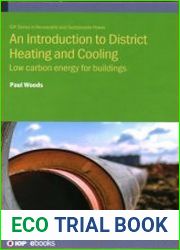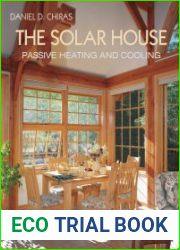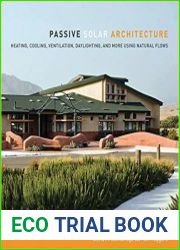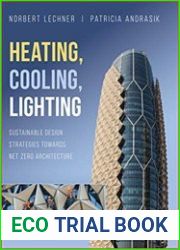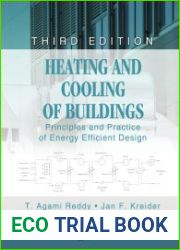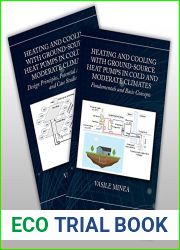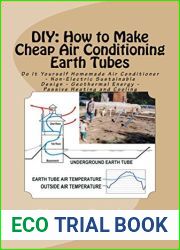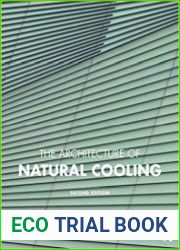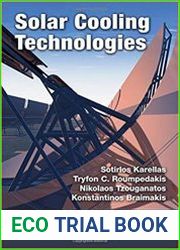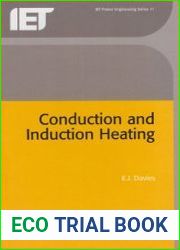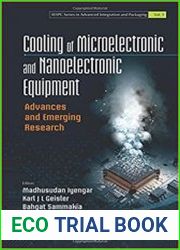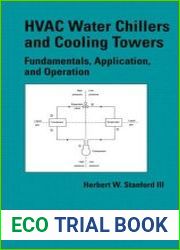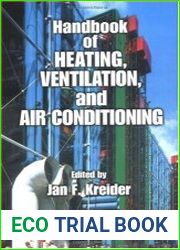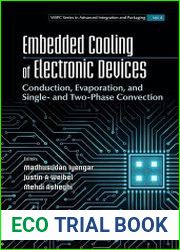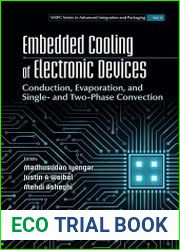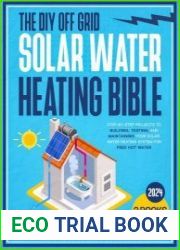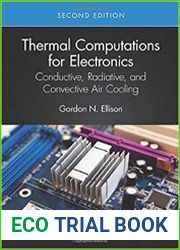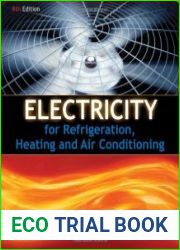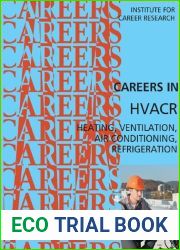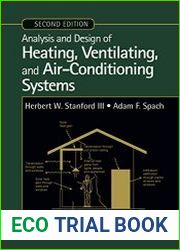
BOOKS - Introduction to District Heating and Cooling Low carbon energy for buildings

Introduction to District Heating and Cooling Low carbon energy for buildings
Author: Paul Woods
Year: 2024
Pages: 265
Format: PDF
File size: 46,2 МБ
Language: ENG

Year: 2024
Pages: 265
Format: PDF
File size: 46,2 МБ
Language: ENG

The book "Introduction to District Heating and Cooling Low Carbon Energy for Buildings" provides a comprehensive overview of the principles and practices of district heating and cooling systems, which have gained increasing attention in recent years due to their potential to reduce greenhouse gas emissions and improve energy efficiency in urban areas. The book covers the history of district heating and cooling, the benefits and challenges of implementing these systems, and the various technologies and strategies used to optimize their performance. The book begins by exploring the historical development of district heating and cooling systems, highlighting key milestones and innovations that have shaped the industry today. It then delves into the fundamental principles of these systems, explaining how they work and the different types of heat exchangers, pumps, and pipelines used in their design. The authors also discuss the various sources of energy used to power district heating and cooling systems, including biomass, geothermal, and waste heat from industrial processes. The book examines the benefits of district heating and cooling systems, such as reduced energy consumption, lower emissions, and improved air quality. However, it also acknowledges the challenges associated with these systems, such as high upfront costs, complex infrastructure requirements, and potential conflicts with local communities.
В книге «Introduction to District Heating and Cooling Low Carbon Energy for Buildings» (Введение в централизованное отопление и охлаждение с низким содержанием углерода для зданий) представлен всесторонний обзор принципов и практики систем централизованного отопления и охлаждения, которые в последние годы привлекают все большее внимание благодаря их потенциалу сократить выбросы парниковых газов и повысить энергоэффективность в городских районах. Книга охватывает историю централизованного отопления и охлаждения, преимущества и проблемы внедрения этих систем, а также различные технологии и стратегии, используемые для оптимизации их производительности. Книга начинается с изучения исторического развития систем централизованного теплоснабжения и охлаждения, выделяя ключевые вехи и инновации, которые сформировали индустрию сегодня. Затем он углубляется в фундаментальные принципы этих систем, объясняя, как они работают, и различные типы теплообменников, насосов и трубопроводов, используемых в их конструкции. Авторы также обсуждают различные источники энергии, используемые для питания районных систем отопления и охлаждения, включая биомассу, геотермальную энергию и отходящее тепло от промышленных процессов. В книге рассматриваются преимущества систем централизованного отопления и охлаждения, такие как снижение потребления энергии, снижение выбросов и улучшение качества воздуха. Однако он также признает проблемы, связанные с этими системами, такие как высокие первоначальные затраты, сложные требования к инфраструктуре и потенциальные конфликты с местными сообществами.
Introduction to District Heating and Cooling Low Carbon Energy for Buildings (Introduction au chauffage et au refroidissement centralisés à faible teneur en carbone pour les bâtiments) présente un aperçu complet des principes et des pratiques des systèmes de chauffage et de refroidissement urbains, qui ont attiré de plus en plus l'attention ces dernières années en raison de leur potentiel de réduction des émissions de gaz à effet de serre et d'une augmentation des émissions efficacité énergétique dans les zones urbaines. livre couvre l'histoire du chauffage et du refroidissement urbains, les avantages et les défis de la mise en œuvre de ces systèmes, ainsi que les différentes technologies et stratégies utilisées pour optimiser leurs performances. livre commence par une étude du développement historique des systèmes de chauffage et de refroidissement centralisés, soulignant les étapes clés et les innovations qui ont façonné l'industrie aujourd'hui. Il se penche ensuite sur les principes fondamentaux de ces systèmes en expliquant comment ils fonctionnent et les différents types d'échangeurs de chaleur, de pompes et de conduites utilisés dans leur conception. s auteurs discutent également des différentes sources d'énergie utilisées pour alimenter les systèmes de chauffage et de refroidissement urbains, y compris la biomasse, l'énergie géothermique et la chaleur des processus industriels. livre examine les avantages des systèmes de chauffage et de refroidissement urbains, tels que la réduction de la consommation d'énergie, la réduction des émissions et l'amélioration de la qualité de l'air. Toutefois, il reconnaît également les défis associés à ces systèmes, tels que les coûts initiaux élevés, les exigences complexes en matière d'infrastructure et les conflits potentiels avec les collectivités locales.
libro Introducción a la calefacción y la refrigeración centralizadas con bajo contenido de carbono para edificios ofrece una visión general completa de los principios y prácticas de los sistemas centralizados de calefacción y refrigeración que en los últimos los han atraído cada vez más la atención debido a su potencial para reducir las emisiones de gases de efecto invernadero y mejorar la eficiencia energética en las zonas urbanas. libro abarca la historia de la calefacción y refrigeración centralizadas, las ventajas y desafíos de la implementación de estos sistemas, así como las diferentes tecnologías y estrategias utilizadas para optimizar su rendimiento. libro comienza explorando el desarrollo histórico de los sistemas centralizados de calefacción y refrigeración, destacando los hitos e innovaciones clave que han dado forma a la industria en la actualidad. Luego se profundiza en los principios fundamentales de estos sistemas, explicando cómo funcionan y los diferentes tipos de intercambiadores de calor, bombas y tuberías utilizadas en su diseño. autores también discuten las diferentes fuentes de energía utilizadas para alimentar los sistemas de calefacción y refrigeración de los distritos, incluyendo la biomasa, la energía geotérmica y el calor residual de los procesos industriales. libro aborda los beneficios de los sistemas centralizados de calefacción y refrigeración, como reducir el consumo de energía, reducir las emisiones y mejorar la calidad del aire. n embargo, también reconoce los desafíos asociados con estos sistemas, como los altos costos iniciales, los complejos requisitos de infraestructura y los posibles conflictos con las comunidades locales.
L'introduzione al riscaldamento centralizzato e al raffreddamento a basso contenuto di carbonio per gli edifici offre una panoramica completa dei principi e delle pratiche dei sistemi di riscaldamento e raffreddamento centralizzati che negli ultimi anni hanno attirato una crescente attenzione grazie al loro potenziale di ridurre le emissioni di gas serra e aumentare le pratiche di riscaldamento e raffreddamento centralizzati efficienza energetica nelle aree urbane. Il libro comprende la storia del riscaldamento e del raffreddamento centralizzato, i vantaggi e i problemi di implementazione di questi sistemi e le diverse tecnologie e strategie utilizzate per ottimizzare le loro prestazioni. Il libro inizia esplorando lo sviluppo storico dei sistemi di riscaldamento e raffreddamento centralizzati, evidenziando le principali fasi cardine e innovazioni che oggi hanno formato l'industria. Poi si approfondisce nei principi fondamentali di questi sistemi, spiegando come funzionano e i diversi tipi di scambiatori di calore, pompe e tubazioni utilizzati nel loro progetto. Gli autori discutono inoltre di diverse fonti di energia utilizzate per alimentare i sistemi di riscaldamento e raffreddamento distrettuale, tra cui biomassa, energia geotermica e calore fuoriuscito dai processi industriali. Il libro descrive i vantaggi dei sistemi di riscaldamento e raffreddamento centralizzati, come la riduzione del consumo energetico, la riduzione delle emissioni e il miglioramento della qualità dell'aria. Tuttavia, riconosce anche i problemi associati a questi sistemi, quali gli elevati costi iniziali, le complesse esigenze infrastrutturali e i potenziali conflitti con le comunità locali.
Das Buch „Introduction to District Heating and Cooling Low Carbon Energy for Buildings“ bietet einen umfassenden Überblick über die Prinzipien und Praktiken von Fernwärme- und Fernkältesystemen, die in den letzten Jahren aufgrund ihres Potenzials zur Reduzierung von Treibhausgasemissionen und zur Verbesserung der Energieeffizienz in städtischen Gebäuden zunehmend an Bedeutung gewonnen haben Bezirken. Das Buch behandelt die Geschichte der Fernwärme und -kühlung, die Vorteile und Herausforderungen der Implementierung dieser Systeme sowie die verschiedenen Technologien und Strategien zur Optimierung ihrer istung. Das Buch beginnt mit einer Untersuchung der historischen Entwicklung von Fernwärme- und -kältesystemen und hebt die wichtigsten Meilensteine und Innovationen hervor, die die Branche heute geprägt haben. Er geht dann auf die grundlegenden Prinzipien dieser Systeme ein und erklärt, wie sie funktionieren und welche verschiedenen Arten von Wärmetauschern, Pumpen und Rohrleitungen bei ihrer Konstruktion verwendet werden. Die Autoren diskutieren auch die verschiedenen Energiequellen, die zur Versorgung von Fernwärme- und Fernkältesystemen verwendet werden, einschließlich Biomasse, Geothermie und Abwärme aus industriellen Prozessen. Das Buch untersucht die Vorteile von Fernwärme- und Fernkältesystemen, wie zum Beispiel die Reduzierung des Energieverbrauchs, die Reduzierung von Emissionen und die Verbesserung der Luftqualität. Er erkennt jedoch auch die mit diesen Systemen verbundenen Herausforderungen an, wie hohe Anschaffungskosten, komplexe Infrastrukturanforderungen und potenzielle Konflikte mit lokalen Gemeinschaften.
מבוא למחוז חימום וקירור אנרגיה פחמן נמוך עבור מבנים מספק סקירה מקיפה של העקרונות והפרקטיקות של מערכות חימום וקירור מחוזיות, אשר זכו לתשומת לב גוברת בשנים האחרונות בשל הפוטנציאל שלהם להפחתת פליטת גזי חממה ושיפור היעילות האנרגטית במחוזות עירוניים. הספר מכסה את ההיסטוריה של החימום והקירור המחוזיים, היתרונות והאתגרים של יישום מערכות אלה, ואת הטכנולוגיות והאסטרטגיות השונות המשמשות לייעול ביצועיהם. הספר מתחיל בבדיקת ההתפתחות ההיסטורית של מערכות החימום והקירור של המחוז, ומדגיש את אבני הדרך והחידושים המרכזיים שעיצבו את התעשייה כיום. לאחר מכן הוא מתעמק בעקרונות היסודיים של מערכות אלה, ומסביר כיצד הן עובדות והסוגים השונים של מחליפי חום, משאבות וצינורות המשמשים בעיצוב שלהם. המחברים גם דנים במקורות אנרגיה שונים המשמשים להפעלת מערכות חימום וקירור מחוזיות, לרבות ביומסה, אנרגיה גיאותרמית וחום פסולת מתהליכים תעשייתיים. הספר בוחן את היתרונות של מערכות חימום וקירור מחוזיות, כגון צריכת אנרגיה מופחתת, הפחתת פליטות ושיפור איכות האוויר. עם זאת, היא גם מכירה באתגרים הנלווים למערכות אלה, כגון עלויות גבוהות מראש, דרישות תשתית מורכבות וקונפליקטים פוטנציאליים עם קהילות מקומיות.''
Binalar için Bölgesel Isıtma ve Soğutmaya Giriş Binalar için Düşük Karbonlu Enerji, kentsel bölgelerde sera gazı emisyonlarını azaltma ve enerji verimliliğini artırma potansiyelleri nedeniyle son yıllarda artan ilgi gören bölgesel ısıtma ve soğutma sistemlerinin ilke ve uygulamalarına kapsamlı bir genel bakış sunar. Kitap, bölgesel ısıtma ve soğutmanın tarihini, bu sistemlerin uygulanmasının yararlarını ve zorluklarını ve performanslarını optimize etmek için kullanılan çeşitli teknolojileri ve stratejileri kapsar. Kitap, bölgesel ısıtma ve soğutma sistemlerinin tarihsel gelişimini inceleyerek, bugün endüstriyi şekillendiren önemli kilometre taşlarını ve yenilikleri vurgulayarak başlıyor. Daha sonra bu sistemlerin temel prensiplerini inceleyerek, nasıl çalıştıklarını ve tasarımlarında kullanılan farklı ısı eşanjörleri, pompalar ve boru tiplerini açıklar. Yazarlar ayrıca biyokütle, jeotermal enerji ve endüstriyel işlemlerden kaynaklanan atık ısı dahil olmak üzere bölgesel ısıtma ve soğutma sistemlerine güç sağlamak için kullanılan çeşitli enerji kaynaklarını tartışmaktadır. Kitap, azaltılmış enerji tüketimi, azaltılmış emisyonlar ve iyileştirilmiş hava kalitesi gibi bölgesel ısıtma ve soğutma sistemlerinin faydalarını incelemektedir. Bununla birlikte, yüksek ön maliyetler, karmaşık altyapı gereksinimleri ve yerel topluluklarla olası çatışmalar gibi bu sistemlerle ilgili zorlukları da kabul eder.
تقدم مقدمة لتدفئة المناطق وتبريد الطاقة منخفضة الكربون للمباني لمحة عامة شاملة عن مبادئ وممارسات نظم التدفئة والتبريد في المقاطعات، التي حظيت باهتمام متزايد في السنوات الأخيرة بسبب قدرتها على تقليل انبعاثات غازات الاحتباس الحراري وتحسين كفاءة الطاقة في المناطق الحضرية. يغطي الكتاب تاريخ التدفئة والتبريد في المنطقة، وفوائد وتحديات تنفيذ هذه الأنظمة، والتقنيات والاستراتيجيات المختلفة المستخدمة لتحسين أدائها. يبدأ الكتاب بفحص التطور التاريخي لأنظمة التدفئة والتبريد في المنطقة، وتسليط الضوء على المعالم والابتكارات الرئيسية التي شكلت الصناعة اليوم. ثم يتعمق في المبادئ الأساسية لهذه الأنظمة، موضحًا كيفية عملها والأنواع المختلفة من المبادلات الحرارية والمضخات والأنابيب المستخدمة في تصميمها. يناقش المؤلفون أيضًا العديد من مصادر الطاقة المستخدمة لتشغيل أنظمة التدفئة والتبريد في المنطقة، بما في ذلك الكتلة الحيوية والطاقة الحرارية الأرضية وهدر الحرارة من العمليات الصناعية. يبحث الكتاب في فوائد أنظمة التدفئة والتبريد في المقاطعات، مثل تقليل استهلاك الطاقة، وخفض الانبعاثات، وتحسين جودة الهواء. ومع ذلك، فإنه يعترف أيضًا بالتحديات المرتبطة بهذه النظم، مثل ارتفاع التكاليف الأولية، ومتطلبات البنية التحتية المعقدة، والنزاعات المحتملة مع المجتمعات المحلية.
《建築物低碳集中供暖和制冷概論》全面概述了近來因減少溫室氣體排放和提高城市能源效率而日益受到關註的集中供暖和制冷系統的原則和做法。該書涵蓋了集中供暖和制冷的歷史,實施這些系統的優點和挑戰,以及用於優化其性能的各種技術和策略。本書首先探討了集中供熱和制冷系統的歷史發展,突出了塑造當今行業的關鍵裏程碑和創新。然後,他深入研究了這些系統的基本原理,解釋了它們的工作原理以及設計中使用的不同類型的熱交換器,泵和管道。作者還討論了用於為區域供暖和制冷系統供電的各種能源,包括生物質,地熱能和工業過程產生的廢熱。該書探討了集中供暖和制冷系統的好處,例如降低能源消耗,減少排放並改善空氣質量。但是,它還認識到與這些系統相關的挑戰,例如高初始成本,復雜的基礎設施要求以及與當地社區的潛在沖突。







